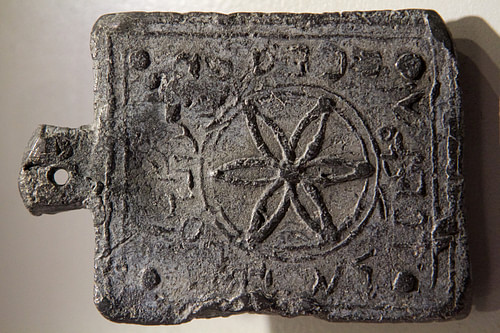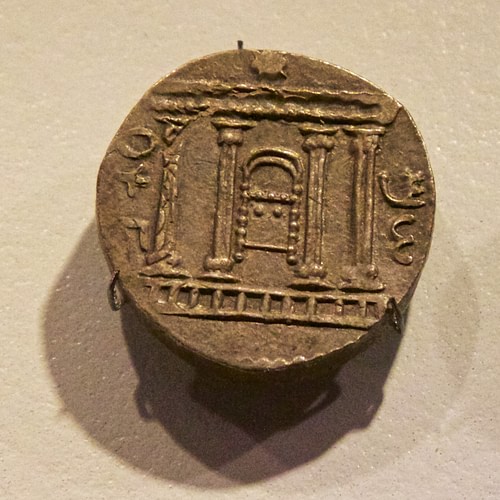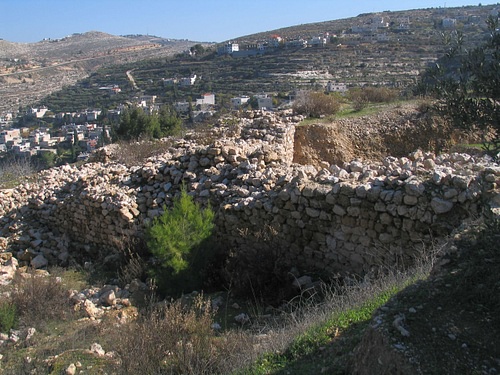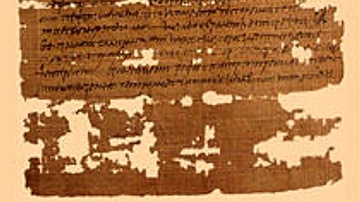
The Bar Kochba Revolt (132–136 CE) was the third and final war between the Jewish people and the Roman Empire. It followed a long period of tension and violence, marked by the first Jewish uprising of 66-70 CE, which ended with the destruction of the Second Temple, and the Kitos War (115-117 CE). In many ways, the Bar Kochba Revolt differed markedly from its predecessors. For the first time, the Jews presented a united front against Roman forces and fought underneath a single charismatic leader, the eponymous Simon Bar Kochba (also given as Shimon Bar-Cochba, Bar Kokhba, Ben-Cozba, Cosiba or Coziba). It was marked as well by strong religious passions, with many apparently believing that Bar Kochba was the promised messiah who would lead the Jewish people to final victory against their enemies.
In its initial stages, the revolt was surprisingly successful and may have resulted in the destruction of an entire Roman legion. It is possible that the rebels regained control of the city of Jerusalem, and they must have held large portions of ancient Judea. The Romans, however, regrouped and adopted a scorched-earth strategy that ultimately extirpated the rebels and laid waste to the country. The war shattered Judean society and led to far-reaching demographic and political changes, with the majority of the Jewish population of the province killed, enslaved, or exiled, and their national hopes definitively crushed. The Jewish people would not regain their political independence until the Zionist era and the establishment of the State of Israel in 1948 CE.
The Problem of Sources
Unlike the revolt of 66 CE, the historical sources on the Bar Kochba Revolt are scanty at best. The war had no chronicler such as Josephus Flavius, at least none whose work has survived. The primary non-Jewish sources are an epitome of Cassius Dio's Roman History and a handful of lines by the ecclesiastical historian Eusebius, the bishop of Caesarea. The war is also briefly mentioned by the Church father Jerome. While by no means comprehensive, these sources do provide several important details.
The Jewish sources are not per se historical and, while also scanty, are found throughout the rabbinical literature of the period and after, in particular, in the Jerusalem and Babylonian Talmuds. While they are often clearly legendary and unreliable in nature, they do paint a general picture of the Jewish experience of the war and its aftermath.
In addition, several important archaeological finds have shed light on certain aspects of the revolt. Coins minted while Judea was temporarily freed from Roman rule indicate the existence of an independent Jewish state for a brief period. In the 1960s CE, a cave in the Judean desert was found that likely once housed refugees from the revolt. Called the “Cave of Letters,” it contained a cache of documents that included several letters from Bar Kochba himself, which shed unprecedented light on his personality and style of rule.
Simon Bar Kochba
The leader under whom the Jews united in their final war against the Romans remains one of the most important and enigmatic figures in Jewish history. Almost nothing is known about him, and he does not even appear in Dio's comments on the war, though he may have done in the now-lost original. Eusebius, Jerome, and the rabbinic literature all mention Bar Kochba, but by no means provide a complete picture, though the Jewish sources are by far the most detailed.
Even his name remains something of a mystery. 'Bar Kochba' is clearly an epithet, as it means "son of a star" in Aramaic, which appears to have been a messianic appellation. The rabbinical sources refer to him throughout as Shimon Ben-Cozba or Coziba, which is often turned into a play on the word cuzav, meaning 'fake' or 'falsehood,' indicating their view of Bar Kochba as a false messiah. In the Bar Kochba Letters, discovered in the Judean Desert in the 1960s CE, he refers to himself as Shimon Ben-Cosiba.
Perhaps the most famous reference to Bar Kochba in the rabbinic literature is one in which the venerated Rabbi Akiva says to his colleagues of Ben-Cosiba, hu malcha mashicha, "he is the king messiah," and references the biblical phrase "a star will come forth from Jacob." Another rabbi then drily replies, "Grass will be growing from your cheeks and the son of David will still not have come" (Midrash Rabba Eicha 2:2.4).
This appears to strongly indicate that, while it was by no means a consensus opinion, there was a strong and widespread belief that Bar Kochba was the promised messiah. In all likelihood, then, the revolt was not only a political or military event but also a strongly religious one, powered by the intense passions of messianic belief in the coming redemption of Israel.
Eusebius also describes an intense messianic aura surrounding Bar Kochba, who he calls 'Barchochebas,' saying this means "son of a star." He writes that the leader was "a man who was murderous and a bandit, but relied on his name, as if dealing with slaves, and claimed to be a luminary come from heaven and was magically enlightening those who were in misery" (Eusebius, History of the Church, 4:6.2).
This may also be indicated by the fact that, in one of the unearthed letters, Bar Kochba is described as nasi yisrael or "prince of Israel," indicating that the leader had or claimed to have restored the Jewish kingship, which was considered an essential accomplishment for any messianic claimant.
As noted, Eusebius' comments on Bar Kochba were entirely negative, likely because his messianic claim challenged that of Jesus, as well as Bar Kochba's claimed oppression of Judea's Christians. However, the Jewish sources are not particularly positive either. He is referred to at certain points as something of a legendary hero, at one point supposedly deflecting a ballista with his leg. For the most part, however, he is reviled as a false messiah who brought disaster on his people. In one story, he is portrayed as kicking an elderly rabbi to death for a perceived infraction. In another, he ignores rabbinical advice on mutilating his soldiers, thus defying the will of God and bringing about his army's downfall. The rabbis even take credit for assassinating the tyrannical leader, though this story is almost certainly apocryphal.
The Bar Kochba letters give a more nuanced, albeit brief glimpse of his character. For the most part, he is imperious and demanding, telling one correspondent he must furnish more troops for his army, in another he is calling for sacred crops to be sent for the holiday of Sukkot. However, there is little to indicate that he was unusually tyrannical by the standards of the time. From the little that can be gleaned, a general picture of Bar Kochba emerges of a charismatic, physically courageous, somewhat brutal, and at times tyrannical leader who led his followers and perhaps himself to believe that he was a messianic king born to free his people. His failure to do precisely this led to horrendous consequences for the Jews and his later excoriation as a false messiah.
Causes of the Revolt
Even the causes of the Bar Kochba revolt remain unclear. Cassius Dio states that the war broke out due to Emperor Hadrian's (r. 117-138 CE) decision to reconstitute Jerusalem as a pagan city with a temple to Jupiter on the site of the Second Temple. Eusebius, by contrast, seems to imply that this was a result of the war rather than a cause, although this is somewhat ambiguous. In addition, the sources indicate that Hadrian attempted to repress certain important Jewish rituals, in particular circumcision. Added to this would have been the Jews' desire to be readmitted to Jerusalem and rebuild the Temple, as well as the demographic pressure of an increasing number of Greek and Roman colonists.
It also appears that the Roman governor of Judea, Quintus Tineius Rufus, was a particularly hated and tyrannical official, arousing Jewish ire against him and Roman rule in general. The Talmud describes him as "the wicked" and states that he personally "plowed the Sanctuary," i.e. the Temple site, and issued a writ of execution for the revered Rabbi Gamliel (Talmud HaBavli, Taanit 29a). In another passage, Rufus taunts Rabbi Akiva, deriding the Jews as "slaves" (T.B., Bava Batra 10a).
Unlike its predecessors, the revolt was not spontaneous but carefully planned. The Jews collected armaments, dug extensive tunnel systems for guerrilla warfare, and united politically and militarily under a single leader, as opposed to the extensive infighting that marked the first revolt. Showing a capacity for careful strategy, they waited until Hadrian had finished his tour of the eastern provinces before rising up and appear to have caught the Romans entirely by surprise.
The Uprising
What details of the actual revolt remain to us are mostly through the epitome of Cassius Dio. According to Dio, the Jews initially employed guerrilla warfare, using their extensive network of underground tunnels and similar means. The war quickly intensified, however, until "the whole earth, one might almost say, was being stirred up over the matter" (Dio, 69:12.1). The extent to which the Jews succeeded in establishing control over the province is not clear, though they must have commanded extensive territory at the height of the revolt. It is debated among historians whether Jerusalem itself was captured. A coin from the period refers to herut yerushalayim, or "the freedom of Jerusalem," but this may have been figurative.
Hadrian then dispatched his best generals, most notably Julius Severus. The fact that Severus had to be dispatched from as far away as Britain indicates the seriousness of the Romans' predicament. Severus adopted a slow but extremely brutal strategy, steadily crushing the rebels by destroying the infrastructure and indeed much of the Jewish population of Judea. Dio writes:
50 of their most important outposts and 985 of their most famous villages were razed to the ground. 580,000 men were slain in the various raids and battles, and the number of those that perished by famine, disease, and fire was past finding out. [...] nearly the whole of Judea was made desolate. (Dio, 69:14.1-2)
Jerome writes:
Jerusalem was completely destroyed and the Jewish nation was massacred in large groups at a time, with the result that they were even expelled from the borders of Judaea. [...] That being the time when Barcochebas, the leader of the Jews, was crushed and Jerusalem was demolished to the very ground. (Jerome, Commentary on Daniel, Chapter 9)
The Jewish sources are far more explicit, with tales of Roman soldiers smashing babies against rocks and the mass slaughter of civilians. One story relates that Hadrian was able to build a wall of corpses several miles long. While clearly somewhat apocryphal, these stories appear to reflect the reality of an extremely brutal campaign of what in modern terms would likely be called ethnic cleansing.
Both Eusebius and the Jewish sources agree that the war ended with Bar Kochba and his men making a final stand at the fortress of Beitar near Jerusalem. "The siege lasted a long time before the rebels were driven to final destruction by famine and thirst and the instigator of their madness paid the penalty he deserved," Eusebius writes (4:6.3). The Jewish sources relate that when Beitar fell "men, women, and children were slain until their blood ran into the great sea," i.e. the Mediterranean, while another story tells of students and teachers of Jewish law being wrapped in the sacred scrolls and burned to death (Talmud HaBavli, Gittin 57a).
Most tellingly, the rabbis linked the fall of Beitar to the worst disasters to befall the Jewish people.
On the Ninth of Av, it was decreed upon our ancestors that they would not be allowed to enter the Land of Israel, the First and Second Temples were destroyed, Beitar was captured, and the city of Jerusalem was plowed over. (Mishnah Taanit 4:6)
The fate of Bar Kochba himself is not clear, though the sources indicate that he most likely died in the final battle for Beitar or shortly before.
Aftermath
What followed the fall of Beitar was in many ways as horrendous as the war itself. Hadrian went so far as to permanently change the name of Judea to Palestina, effectively erasing its Jewish past. Jewish law and rituals were banned for some time, and many Jewish religious leaders were martyred, including Rabbi Akiva, who had believed so fervently in Bar Kochba as the messiah. Most tellingly, Jerusalem was permanently converted into a pagan city called Aelia Capitolina, and the Jews were forbidden to live within sight of it. Eusebius quotes Ariston of Pella stating,
Thus when the city came to be bereft of the nation of the Jews, and its ancient inhabitants had completely perished, it was colonized by foreigners, and the Roman city which afterwards arose changed its name, and in honor of the reigning emperor Aelius Hadrian was called Aelia. (4:6.4)
This may have been something of a moot point, however, as the majority of the Jewish population had either been killed, died of disease or starvation, or been sold into slavery. While small Jewish communities continued to exist, such as in the Galilee, the demography of Judea had shifted in favor of the non-Jewish population, as it would remain for almost 2,000 years until the advent of Zionist immigration. As a result, the remaining centers of Jewish cultural and religious life were all outside the land of Israel, especially in Babylonia, where the definitive codex of Jewish law – the Babylonian Talmud – was collected and redacted. In effect, the Jews were now a stateless people and would remain so until 1948 CE.
It seems clear, however, that the war was also very costly for the Romans. Indeed, it has been speculated that the legendary "lost legion," the Legio IX Hispana, was destroyed during the revolt, as it disappears from the historical records around this time. Dio recounts that, following the war, "Hadrian, in writing to the Senate, did not employ the opening phrase commonly affected by the emperors, 'If you and your children are in health, it is well; I and the legions are in health'" (69:14.3).
Historical Memory
The historical memory of the Bar Kochba Revolt has been much weaker than that of the Jewish revolt of 70 CE, perhaps because of the spectacular tragedy of the Temple's destruction, perhaps because no detailed history of it still survives today. Nonetheless, Bar Kochba has remained alive in historical memory. To the Romans, the revolt was best forgotten but was sometimes cited as an example of a particularly bloody and brutal confrontation with an intractable enemy. To Christians, the revolt was further proof of their new faith's superiority over Judaism. In particular, they contrasted Bar Kochba's status as a failed messiah with what they believed to be Jesus' genuine claim.
For the Jews, the revolt was the last in a series of historical disasters, and for the most part, they sought to escape its trauma through silence. For such a catastrophic event, surprisingly little was written about it. When it was spoken of, it was usually to degrade Bar Kochba as a false messiah and lament the extremism that led to the doomed revolts against Rome. While the messianic idea survived in Judaism, it became much more tightly controlled, concealed in mystical and exegetical tradition. Messianic claimants were universally distrusted, and Jews were, for the most part, actively discouraged from following them.
With the rise of Zionism, however, the revolt and particularly Bar Kochba himself were reevaluated, and he came to be seen by some as a national hero who made a courageous if doomed last stand against foreign tyranny. The holiday Lag B'Omer, originally related to the Kabbalah, was remade as a celebration of Bar Kochba and his revolt. At the same time, however, others have warned against the new mythology of Bar Kochba, believing it could result in the same disastrous outcome as the revolt itself. In today's world, with the contention between the ancient narrative of disaster and modern narrative of heroism, Bar Kochba remains what perhaps he always was – a fascinating and unknowable enigma.











